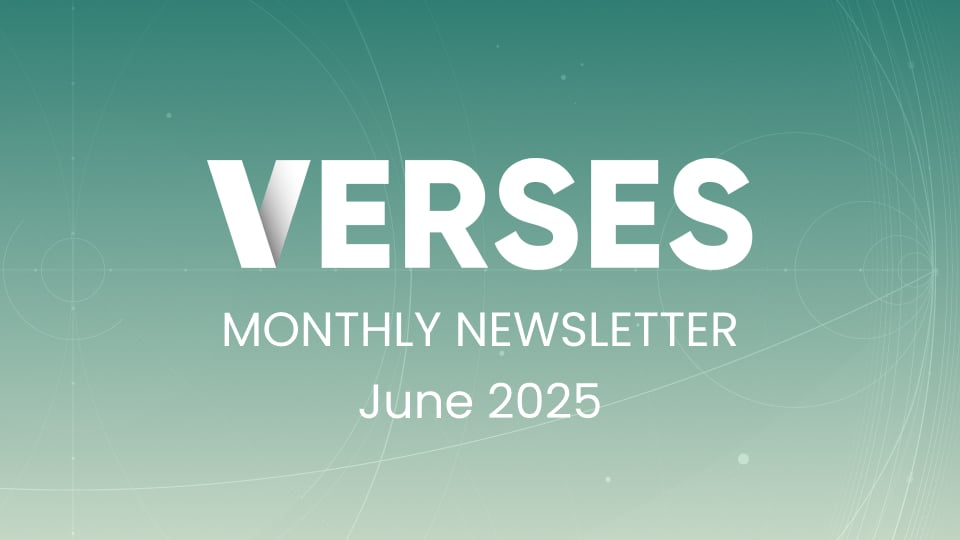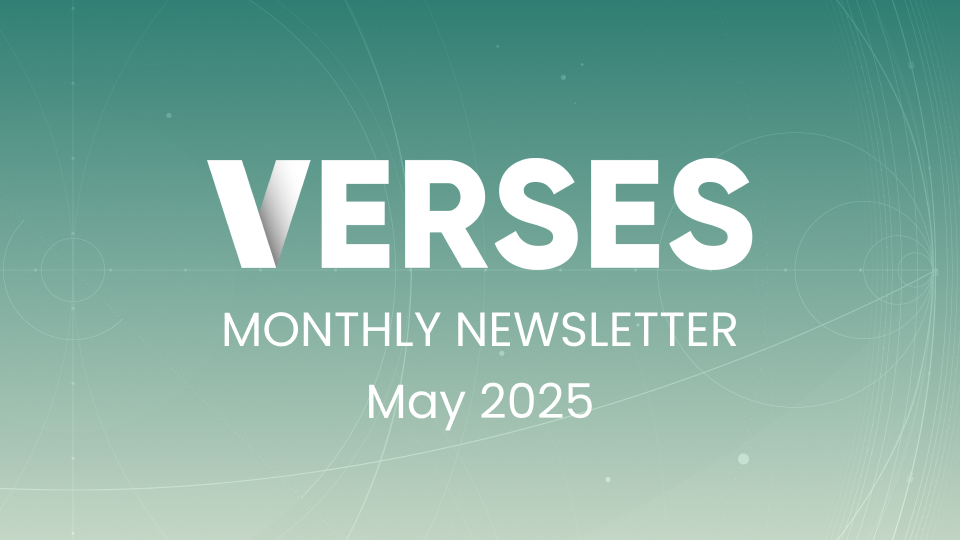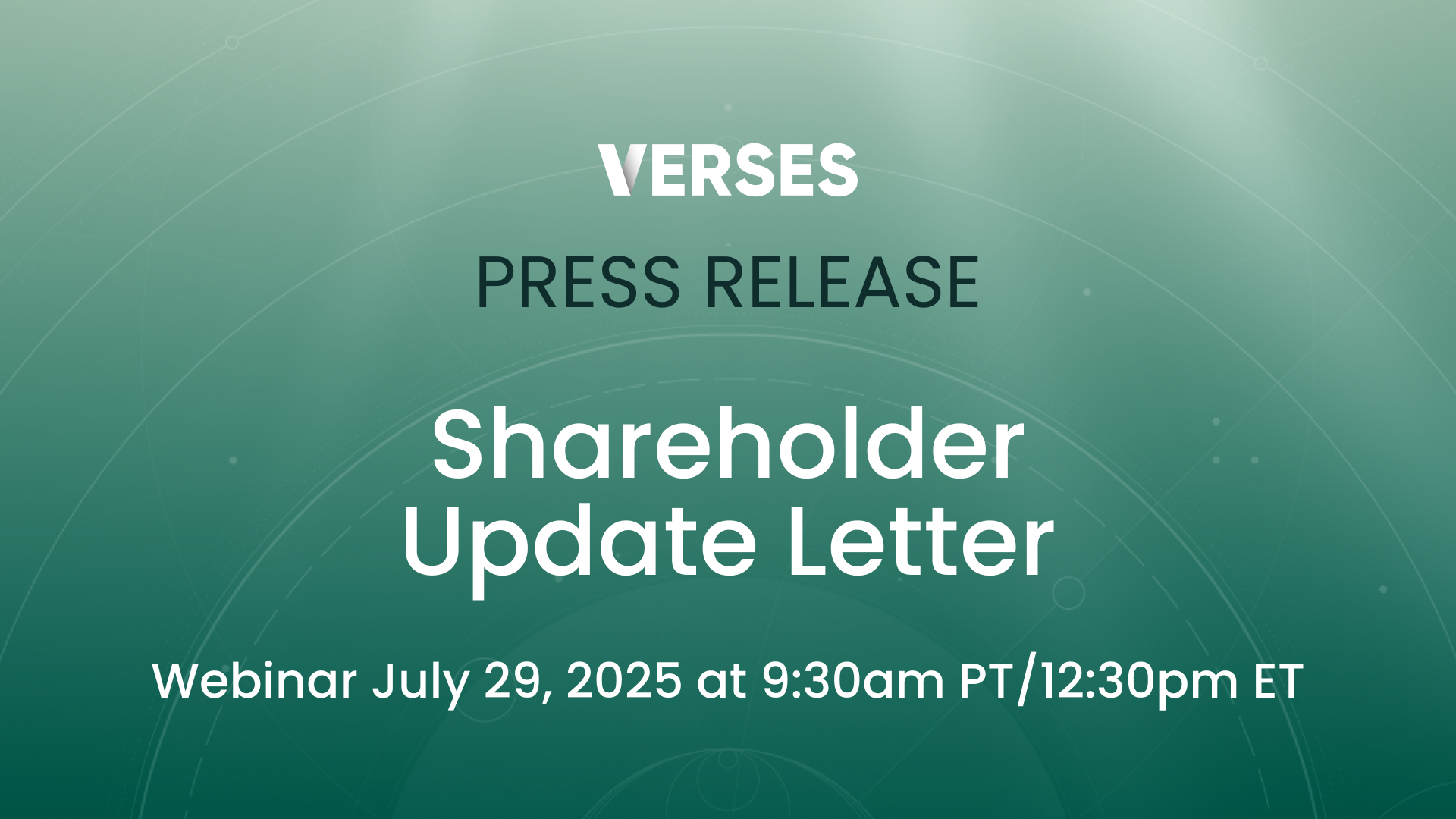
VERSES® is now trading on OTCQB:VRSSF and CBOE:VERS
VANCOUVER, British Columbia – VERSES AI Inc. (CBOE: VERS) (OTCQB: VRSSF) (“VERSES” or the “Company”) is pleased to announce the launch of its inaugural monthly newsletter.
FROM THE CEO
VERSES vision for the Intelligence Age is far greater than pattern recognition on a grand scale.
Our mission has always been to translate insights about the human brain into more effective and trustworthy machine intelligence—not for a few $100 billion data centers, but for 100 billion devices. Intelligence that mirrors the human brain’s remarkable adaptability, efficiency, and reliability has always been our north star.
Today, I'm pleased to highlight three milestone achievements just in the last month that are turning that our mission into practical reality.
- This past month, we showed how we methodically transformed advanced research into the commercial launch of Genius, our agentic enterprise intelligence platform for generating reliable domain-specific predictions and decisions.
- We introduced AXIOM, a “digital brain” architecture, via the Gameworld 10K benchmark. Architected by VERSES Chief Scientist, Professor Karl Friston, AXIOM mirrors biological intelligence, with lightning-fast, interpretable predictions.
- After 5 years of diligent contributions by P2874 Spatial Web working group members, the IEEE-SA ratified the Spatial Web standards, HSML and HSTP, which pave the way for an interoperable and trustworthy network of agentic hardware and software systems.
These milestones are just the beginning of a future with thriving ecosystems of intelligence.
Sincerely,
Gabriel René
Founder and CEO of VERSES
KARL’S CORNER
From a research and development perspective, this has been an eventful month.
I will take this opportunity to focus on AXIOM, what it brings to the table and the crosscutting themes that underwrite Genius and the IEEE standards for the Spatial Web.
AXIOM is the dénouement of an impressive amount of work by the R&D team. It realises many of the core principles to which the VERSES approach to cognitive computing is committed. In fact, it is difficult to pick out one of the many advances that could be highlighted. This newsletter is a nice opportunity to briefly rehearse a couple of these advances—that can be best seen in relation to conventional machine learning approaches.
Conventionally, in machine learning, one is supplied with a neural network with some preconfigured and overly expressive architecture, for example, a foundation model or deep neural network. However, this architecture—in virtue of its generality—can never be optimal for any specialised application, because the architecture has to reflect the cause-effect structure in the way that data or content are generated.
This structure ‘carves nature at its joints’, which necessarily requires a modular or factorial architecture. AXIOM takes a fundamentally different approach:
Instead of starting from an oversized unstructured network, AXIOM self-assembles and grows itself; adding to the structure whenever some new data cannot be explained or generated.
One thing that impressed me was that the team was able to implement one of the principles of active inference; namely, to choose actions—or select data—that enhances learning.
To my mind, this is a key advance that is missing from conventional approaches.
It means that AXIOM can outperform standard machine learning with a marked improvement in sample efficiency and an efficient and compact network structure (with a fraction of the number of parameters).
In short, AXIOM foregrounds a completely new approach to cognitive computing, in which core priors endow neural networks with the capacity to grow and learn their own structure, much like real brains.
One may ask how this relates to Genius or, indeed, the IEEE standards. The relationship is quite fundamental. Exactly the same principles that are installed in the design and message passing in AXIOM are being instantiated in Genius.
Furthermore, the IEEE standards—that were accepted this month—have been carefully crafted to support the same kind of message passing and belief propagation upon which AXIOM (and Genius) rests.
This means, in principle, one should be able to recapitulate the efficiency, autodidact and Bayes optimal functionality showcased by AXIOM on the spatial web. Mathematically, this rests on the formalism of (variational) message passing on a particular kind of network called a ‘factor graph’ that can be deployed in a scale-free fashion.
Intuitively, this means that one should be able to realise intelligent transactions and federated inference both within a synthetic brain (e.g., Genius) and between synthetic (and real) brains (e.g., under the IEEE standards).
Professor Karl Friston
Chief Scientist, VERSES
LATEST NEWS
- News: Major Global Investment Firm Upgrades to Genius Enterprise Based on Early Project Success
- In the media: Gabriel René and Karl Friston were interviewed by Diginomica, published today: "Growing better brains - why we need to re-think the neuron for more trustworthy and efficient AI"
- Genius Q&A: We have published a Q&A with our CTO Hari Thiruvengada providing more information about Genius.
RESEARCH

This month, VERSES research team published groundbreaking results in a new scientific paper titled “AXIOM: Learning to Play Games in Minutes with Expanding Object-Centric Models.” AXIOM AXIOM (Active eXpanding Inference with Object-centric Models) is a novel digital brain architecture that learns, reasons, and adapts more naturally and efficiently than conventional AI models.
To demonstrate AXIOM’s general adaptive capabilities, we developed the Gameworld 10k benchmark comprising ten classic arcade games with a strict 10,000-step training cap. Gameworld 10k more effectively measures how agents can generalize across tasks and reward genuine understanding over mere memorization than existing video game benchmarks.
Gameworld 10k Performance Highlights (AXIOM vs DreamerV3)
- 60% better gameplay (normalized performance score: 77 vs 48)
- 6x more sample-efficient (learned in 3,175 steps vs 24,207)
- 39x faster in GPU runtime (~10 minutes vs ~370 minutes)
- 39x cheaper to run (estimated GPU cost: $0.66 vs $25.54)
- 400x smaller in model size (0.95 million vs 420 million parameters)
“Soothsayer has validated the claims of AXIOM achieving significant gains over leading deep reinforcement learning models,” said Akshay Deshpande, Soothsayer Senior Director of AI and lead researcher on the project. “Our evaluation found that AXIOM’s efficiency stems from its integration of Variational Bayesian Inference with Active Inference, enabling more human-like learning with fewer interactions and faster convergence.”
AXIOM’s approach offers:
- Reliability. Rapid and consistent learning across multiple contexts.
- Efficiency. Significantly lower computational demands and energy use.
- Adaptability. Robust performance under changing conditions and novel situations.
- Explainability. Transparent decision-making processes that meet regulatory and stakeholder trust requirements.
Unlike traditional deep learning models, which memorize pixel patterns, AXIOM learns by recognizing and modeling real-world objects and their causal relationships. This modular digital brain uses specialized components, each mirroring distinct cognitive functions of the human brain—vision, memory, prediction, reasoning, and planning.
Shepherded by VERSES Chief Scientist, Professor Karl Friston, AXIOM is not a refinement of current state-of-the-art machine learning but a fundamentally different approach to how agentic systems can behave. AXIOM will be integrated into a Genius.
Read more:
- VERSES® Digital Brain Beats Google’s Top AI At “Gameworld 10k” Atari Challenge
- Whitepaper: Mastering Gameworld 10k in Minutes with the AXIOM ‘Digital Brain’
PRODUCT

Focus. Focus. Focus.
Since the launch of Genius, we have focused on getting it to customers who will gain the most value.
This focus has been on high-value use cases and customers who need Genius's features. These include users who are:
- Machine learning practitioners and data scientists who have direct access to the data and deeply understand the problem they are tasked with solving.
- Working on problems aligned with Genius’ strength at generating domain-specific reliable predictions and decisions.
- Experienced with existing machine learning tools and methods and understand their limitations especially as it relates to reliability, explainability, and efficiency.
- Enterprise users with a sense of urgency for solving high-impact problems that have volatility, uncertainty, complexity or ambiguity.
In addition to fostering relationships with individual enterprise users we expect that scale will come through a “one-to-many” channel partner strategy such as the following:
- Systems Integrators who provide professional services, which frequently entails large scale digital transformation, to dozens or hundreds of clients.
- AI and Data centric product and platform providers who embed or integrate 3rd party software and services into their enterprise offering.
- AI and Data centric consulting firms who provide advanced analytics, forecasting or point solutions.
The Spatial Web

After a comprehensive 5 year collaboration between P2874 Working Group members, on May 28, 2025 the IEEE Standards Board officially approved the Spatial Web standards—Hyperspace Modeling Language (HSML) and Hyperspace Transaction Protocol (HSTP) with 94% support. The standard is now referred to as IEEE 2874-2025
By encoding meaning, space, time, and rules into data itself, the standards allow any AI—from any company, running on any device—to plug in, coordinate, and act responsibly. This isn’t just about interoperability, it’s about unlocking network effects so intelligence can scale—safely, ethically, and for everyone.
“These standards provide the common ground for intelligent systems to more safely be released and utilized in the physical and social world,” said John C. Havens, former Executive Director of the IEEE Global Initiative on the Ethics of Autonomous and Intelligent Systems. “They represent a key milestone in helping to ensure that as our systems become more advanced and integrated with society, they also become more aligned with societal values.”
“Having participated in the IEEE-SA P2874 Spatial Web Protocol, Architecture and Governance Working Group, I am glad to see the initiative become standard,” said Mike Warner, Senior Standards Specialist at the Treasury’s Office of Financial Research and former Senior Strategist at the Federal Reserve Bank of San Francisco. “I’ve had the opportunity to contribute on many standards, and I think that HSML and HSTP have important potential roles in the emerging era of computing.”
Read more
FORWARD LOOKING DISCLAIMER
Certain information included in this newsletter contains statements that are forward-looking, such as statements related to our flagship product, Genius, the commercial application of Genius and our research developments, as well as developments in the AI sector. Such forward looking information involves important risks and uncertainties that could significantly affect anticipated results in the future and accordingly, such results may differ materially from those expressed in any forward looking statements made by or on behalf of VERSES.
 VERSES
VERSES



